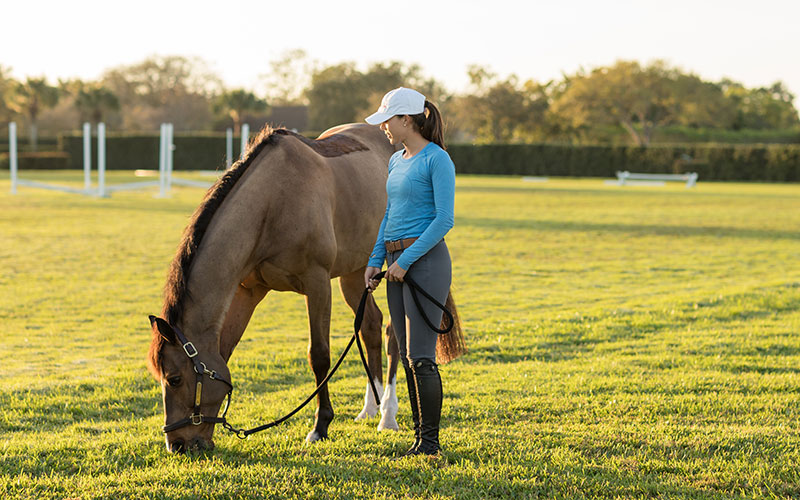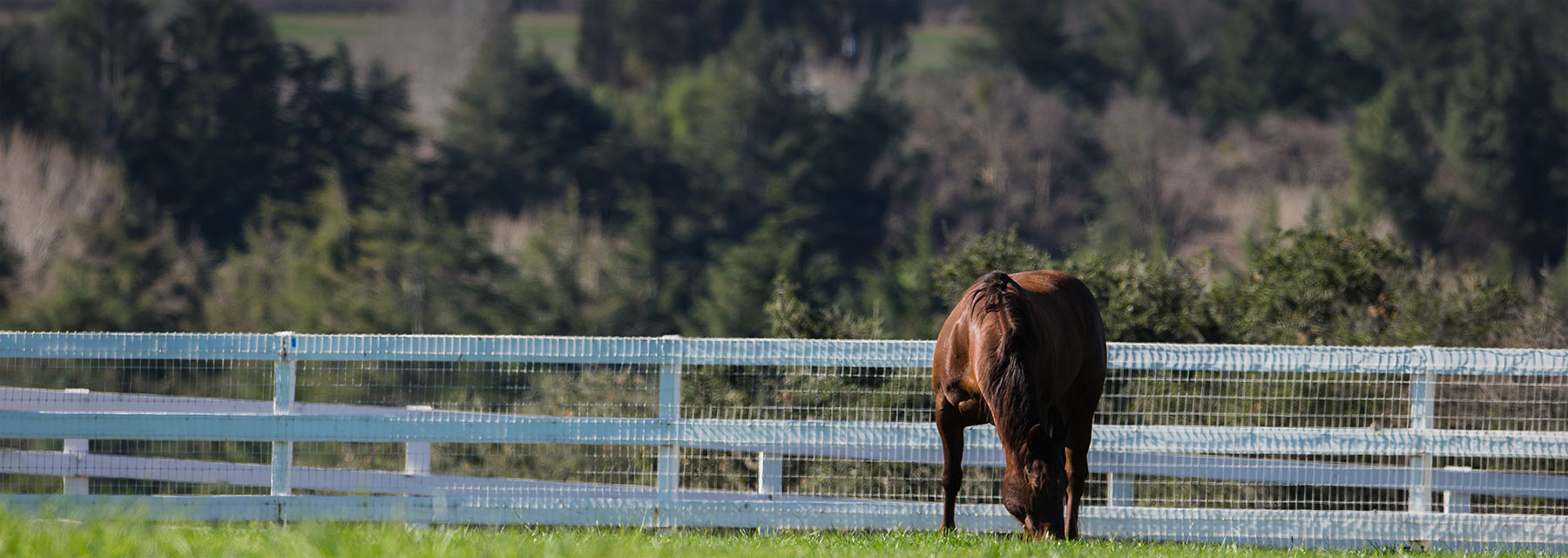Certain feeding protocols can minimize the risk of many types of colic. The following dietary recommendations support general intestinal motility, as well as offer ways to minimize excess starch and sugar in the diet that are contributing risk factors in some colics. Implementing these practices offers benefits for all horses and gives every dietary advantage for horses prone to digestive issues.
Forage First
The Natural Diet of Pasture and Hay
Simulating a natural grazing diet as much as possible is one of the very best things for general gut integrity in horses. The horse’s digestive tract is built in such a way that it thrives on a nearly constant source of fiber or fibrous gut “fill.” Whereas passage of digesta through the stomach and small intestine takes a relatively short amount of time (about 60-90 minutes), the microbial fermentation, which takes place in the hindgut, is a much slower process. The large size and structure of the cecum and large colon is designed for slow passage of digesta to allow time for the beneficial microbes to break down fibrous plant material and extract nutrients and energy from the structural carbohydrate portion of the plant. There must remain enough fibrous fill in the cecum to push digesta out into the large colon for the next stage of digestion. Deprived of the bulk from continuous forage (pasture and/or hay), the many loops of the intestines are more likely to twist or impact. The digestive tract relies on a steady flow of forage and simply does not function properly without it.
Pasture Time
Pasture is nature’s perfect food. Green grass has a nearly perfect nutrient profile, is naturally hydrated with a higher water content, and the low impact movement associated with grazing is highly beneficial for motility within the intestinal tract. While it would be great to have round-the-clock turnout for horses to improve GI motility, it may simply not be a management option. Hay then becomes the cornerstone of digestive health. Hay quality and consistent access are the two most important things. If there are any specific health issues, such as colic, a hay analysis is suggested, particularly if only one type of hay is fed. This will show where nutritional gaps are and how best to fill them.
The Perfect Blend
Energy demands are important in hay selection. Blending hay types is a great way to get the best of all “hay worlds.” Many times what one type lacks in a certain nutrient, another will supply. Purchasing locally is often a good idea to avoid running out and having to make an abrupt switch to another type of hay. Blending a semi-mature type of grass hay with something more digestible whether that is a younger Timothy, Orchardgrass or some alfalfa, usually will provide a really nice overall nutrient profile and supply more energy for horses that need it. Blending hays and using a higher quality grass hay or alfalfa can fill in a lot of the nutrient requirements that are often relied upon by grain. For digestive health it is ideal to maximize nutrition provided by good quality hay and decrease (or eliminate for some horses) the amount of overall grain fed. By feeding this way, it reduces the amount of starch from grains in the diet, which may be a causative factor in many colic cases. It is a healthier alternative to rely more on the calories, protein and mineral composition from the hay, and use the grain only as needed to maintain body condition. Slow feeders are wonderful to encourage a more natural grazing setting. It may not be possible in all cases, but may be something to consider in the evenings, at horse shows or for easy keepers to allow stalled horses access to hay as much as possible and encourage gut motility throughout the day and evening.
Make Changes Gradually
Avoid any abrupt feed changes—whether hay or grain. Even intermittent bran mashes or the occasional alfalfa fed at lunch to horses that would otherwise not receive it can alter the gut microflora and may cause GI upset. Horses should be fed the same throughout the weekend and on off days or “no grain” days…the total volume of grain may be decreased, but it should not be completely skipped if it is part of the daily routine. The GI microflora does change between different types of grains AND hays, and sudden changes can alter the microbiome enough to cause clinical problems, particularly to susceptible horses.

Grain
Keep Starch and Sugar Levels in Mind
For horses that need calories from grains to maintain body condition, a lower non-structural carbohydrate (NSC, water soluble carbohydrates + starch) feed is better due to the fact that a high starch diet is a predisposing factor for many types of colic. Most hays offer more moderate levels of starches and sugars compared to grains, although a hay analysis will give exact levels. Grains and sweet feeds that use cereal grains are typically a major source of starch and potentially sugar dependent on level of molasses used, although it varies widely. Some amount of starch is needed for performance horses, particularly those relying on quick energy at higher speeds or intense activity, but even the most elite athletes do not need the levels found in many commercial feeds at the recommended feeding rate. As a note, starch and sugar content as well as calories per pound are not something that feed companies need to disclose on the guaranteed analysis or any label at this time. If a feed is designated as “low starch,” it does not necessarily mean that it is actually low starch at levels that support intestinal health as there are currently not regulatory guidelines that companies need to adhere to.
System Overload
The trouble with grain is that the capacity of the foregut is ill suited for large, single grain-based meals, particularly with the high level of soluble carbohydrates predominately found in grains. When the relatively small volume of the stomach is overwhelmed from a grain meal, the digesta is quickly pushed into the small intestine. The small intestine is unable to adequately absorb the digestive contents because more continues to pour in. Excess starch spills into the cecum where it is fermented into VFAs (energy), but lactic acid is also formed. Lactic acid can quickly lower the pH of the hindgut where all of the beneficial microbes live. Cecal acidosis can destroy the beneficial microbes and can irritate or actually damage the gut wall. The toxins from dying bacteria can enter the bloodstream and cause laminitis or colic. This is known as carbohydrate overload or hindgut acidosis and is a major reason that maintaining the integrity and balance of the hindgut is so critical. When horses receive too much starch in a meal setting and in combination with low turnout time, it sets them up for excess gas. If grains must be fed, feeding a lower starch grain and feeding smaller amounts throughout the day may allow the small intestine to digest the starch fully, and reduces the chance of it escaping into the colon to be fermented.
Weigh Your Options
There are feed options that would be considered lower starch/sugar feeds. A lot of these have a beet pulp or alfalfa meal base and avoid the major starchy cereal grains altogether such as corn, oats, wheat, barley etc. Some good alternative grain options combine a higher fiber level along with a higher calorie content due to a higher fat percentage. As commodities, common grains as raw materials are less expensive so manufacturing a low starch/high fiber/high fat feed costs more. But as with a lot of things, you pay for what you get. If grain is being fed to maintain body condition, it makes sense to find a higher calorie content pound for pound compared to the many name brand, high-starch feeds as there could be less overall daily grain fed which is healthier from a digestive standpoint. Ration balancers are another option which are more nutrient concentrated and fed at a lower volume. These are not to provide calories as much as they are meant to balance out a hay-only diet to make sure major minerals and protein levels are met. These are great for easy keepers and horses that do not need excess calories to maintain weight, or to facilitate weight loss for overweight horses.
Add Additional Feedings
The fact is that stalled horses fed in a meal-feeding situation are more prone to colic. If it is not possible to make grain changes, splitting the total amount fed into smaller meals (3 lbs or less) and adding a third or even fourth feeding (or as many as possible!) may help digestion. This will make the amount of starch the horse eats per meal more manageable and greatly lower the risk of non-structural carbohydrates escaping metabolism in the small intestine and ending up in the cecum for fermentation, which can lead to acid buildup and gas. Another good practice is to provide hay to the horses first before grain. Horses will preferentially eat grain first which may push it through to the hindgut too quickly and not allow it to be digested properly. For colic prone horses, unabsorbed starch and sugar reaching the hindgut needs to be avoided at all costs. Having forage available at all times, or if this is not possible management-wise, feeding hay first slows down the passage time through the stomach and small intestine and allows the small intestine enzymes time to break down and absorb starch.

Supplements
Support Healthy Digestion with Targeted Nutrition
Probiotic
Live microorganisms help promote digestive health by encouraging the growth of “good” microflora in the animal’s digestive tract. There are 2 strains that I like to see in a good probiotic: Saccharomyces boulardii and Saccharomyces cerevisiae. S. boulardii has diverse benefits including immune support, which promotes and maintains intestinal membrane integrity. S. cerevisiae helps to optimize starch and fiber utilization, reduces lactic acid, helps to maintain intestinal pH, and increases the primary fiber-fermenting bacteria. These are in Platinum Balance®, which I have my horses on and trust extensively.
The Power of Omega-3 Fatty Acids
Omega-3 Fatty Acids can have a wide range of health benefits that include immune and digestive support. Omega-3 fatty acids are found naturally in high concentrations in fresh pasture grass. When grass is cut, cured and baled for hay, the levels of omega-3 fats plummet to inadequate levels. Supplementing with a palatable source of omega-3 fats such as ground flaxseed or flaxseed oil is a way to supplement them back into the diet. This is particularly noteworthy for stalled horses without access to fresh pasture or show horses that may be traveling. Platinum Performance® Equine or Healthy Weight oil both provide high quality palatable sources of omega-3 fatty acids.
Adding Antioxidants
Vitamin E is a versatile fat-soluble antioxidant that may need to be supplemented for horses without access to fresh pasture. Levels decrease over 85% when grass is cut for hay, and is almost completely depleted in older hay cuttings. I recommend the natural type only (d-alpha-tocopheryl acetate) as the synthetic has poor bioavailability.

Key Practices
- Maximize Turnout Time
There is really no true replacement for pasture grazing. The consistent foraging combined with low impact movement is one of the best things for healthy digestion. - Make Changes Slowly
Any dietary changes (including hay and grain changes) should be done gradually, over a 14-day period to avoid gastrointestinal upset and allow the hindgut bacteria to adjust to any new feedstuffs. - Provide Salt
Plain white salt, whether loose or block, should be available to horses at all times, including at shows. Electrolytes should be used when horses have increased sweating from intense exercise, hot weather, etc. They are not something the horse saves in the system for when they are needed; the best time to administer is with an evening meal or after exercise to replenish electrolyte status. - Fresh Water
Fresh, clean water should always be available. - Track Environmental Changes
It is useful to keep a close record of environmental changes (sudden high/low temperatures, weather systems with wide barometric changes) along with dates of feed shipments (and when the feed is first offered to the horses) to identify any potential issues.

by Emily Smith, MS,
Platinum Performance®
